|
|
|
|
|
|
|
|
|
|
|
|
|
 |
 |
 |
 |
|
 |
 |
 |
 |
|
|
For some it's a hiking stick that has set the pace for dozens of backpacking trips. For others it might be a special camp mug for that perfect cup of cocoa. Everyone has an idea of what they can't do without when they take off on an outdoor adventure. The BSA has a list too, the Ten Scout Basic Essentials. Carry them every time you hit the trail and you'll have what you need for making the most of your time in the outdoors.
The Ten Scout Outdoor Essentials are a:
-
Pocketknife
-
Personal First-Aid Kit
-
Extra clothing
-
Rain gear
-
Water bottle
-
Flashlight or Headlamp with Extra Batteries
-
Map and a Compass
-
Matches and Firestarter
-
Sun Protection and Sunglasses
-
Trail Food or Healthy Snacks
| Pocketknife |
 |
The classic all-purpose camping tool includes a can opener, awl, and screwdriver along with one or two sharp blades.
|
| First-Aid Kit |
 |
A personal first aid kit has supplies you can use to treat blisters and other minor wounds, and to be ready to help if more serious situations arise. Of course your kit is only as useful as the knowledge in your head. Passing the first aid rank and merit badge requirements builds a good foundation for being prepared to act effectively in emergencies.
|
|
| Extra Clothing |
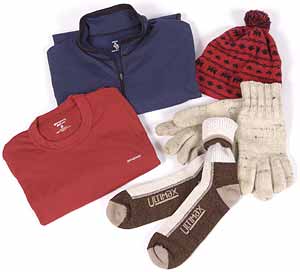 |
A few layers of clothing in your pack allow you to adjust what you're wearing to meet changes in the weather, both hot and cold.
|
|
| Rain Gear |
 |
Carry what you need for the worst conditions you expect. A rain jacket and rain pants are good for almost any season. Add gaiters to keep rain, mud, and snow out of your boots. A poncho can shield you from mild rain, though it tends to blow around in the wind.
|
| Water Bottle |
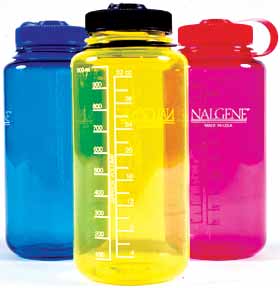 |
Drinking plenty of fluid helps your body fight off heat exhaustion and heat stroke when the sun is beating down, and hypothermia during days that are chilly or cold. Carry the water you need in one or more plastic bottles that fit neatly into outside pockets of your pack. If you take draw water from lakes, streams, or other untested sources, purify it before drinking by adding tablets, by using a filter, or by boiling.
|
| Flashlight or Headlamp with extra batteries |
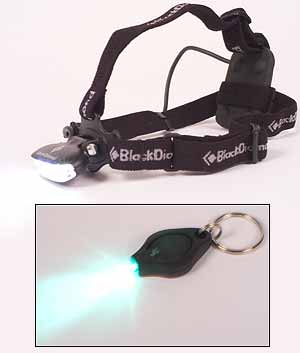 |
Headlamps and flashlights allow you to find your way in the dark or signal for help. Headlamps are conve- nient for hands-free use.
|
| Map and a Compass |
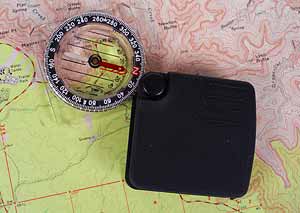 |
A map not only tells where you are and how far you have to go, it can help you find campsites, water, and an emergency exit route in case of an accident. A compass helps you find your way through unfamiliar terrain—especially in bad weather where you can't see the landmarks. A GPS (global positioning system) can also help—but it is no substitute for knowing how to read a map.
|
| Matches and Firestarter |
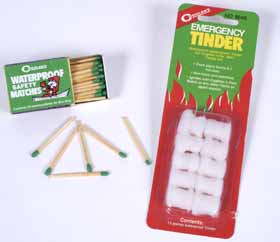 |
The warmth of a fire and a hot drink can help prevent hypothermia. Also, a fire can be a signal for help if you get lost. Carry matches and a small amount of fire starter protected in zipper-locking bags. Dripping candle wax on match tips helps waterproof them. Commercially available windproof and waterproof matches are also a good choice.
Fire starter is anything flammable, from pocket lint to filled-in journal pages. Pine needles and birch bark make especially good starter, even when wet.
|
| Sun Protection and Sunglasses |
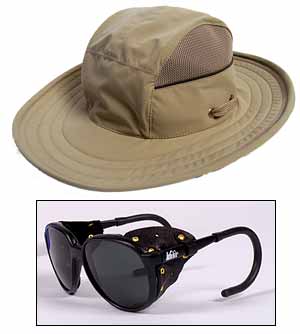 |
Especially above timberline, when there is a skin-scorching combination of sun and snow, you'll need sun-glasses to prevent snow blindness and sunscreen to prevent sunburn. Buy sunglasses that are ultraviolet ray (UV) resis-tant and have side flaps (ventilating holes that keep them from fogging).
Don't use sunscreen that's been sitting in your medicine cabinet for a season or more: It has probably lost at least some of the effectiveness of its sun-protection factor (SPF), a rating of how well and how long the sunscreen will keep you from getting sunburned. A light-colored hat with a wide brim is also an effective sun deterrent. In desert conditions, consider using a long-sleeved light shirt and lightweight loose-fitting long pants. Zipper-off legs give more versatility.
|
| Trail Food and Healthy Snacks |
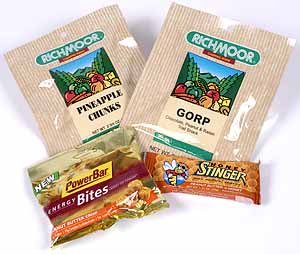 |
Nothing boosts energy and spirits as much as a quick trail snack. You can make your own trail mix with nuts, raisins, banana chips, and chocolate bits. The combination of sugar, fats, and potassium tastes great and provides quick energy, long-lasting calories, and replacement electrolytes.
Always take a bit more food than you think you will need. A lot of things could keep you out longer than expected, like a lengthy detour, get-ting lost, an injury, or difficult terrain.
|
|
|
 |
 |
|
 |
 |
 |
 |
 |
 |
 |
 |
|
 |
 |
 |
 |
|
|
Follow the principles of Leave No Trace and you can be sure you're also conducting every Scout adventure in ways that respect the environment, protect wildlife, and do no harm to the land.
The Boy Scout Handbook, Fieldbook, and other BSA literature offer detailed discussions of Leave No Trace principles. Here's a quick review:
Plan Ahead and Prepare: Research your destination. Know the regulations and be ready when you get there.
Travel and Camp on Durable Surfaces: Stay on trails and use existing campsites whenever you can.
Dispose of Waste Properly: There are safe ways to get rid of dishwater and human waste. Use them.
Leave What You Find: Future visitors will want to enjoy the same environment you do. Help them out.
Minimize Campfire Impacts: Follow local guidelines on when and how to use open fires. Camp stoves are always a good option.
Respect Wildlife: Give animals the space and quiet they need to stay safe.
Be Considerate of Other Visitors: A Scout is Courteous and Kind. Be aware of others on the trail and in campgrounds, and show them that Scouts know how to behave.
|
|
 |
 |
|
 |
 |
 |
 |
|
|
|
|
|
|
|
|
|